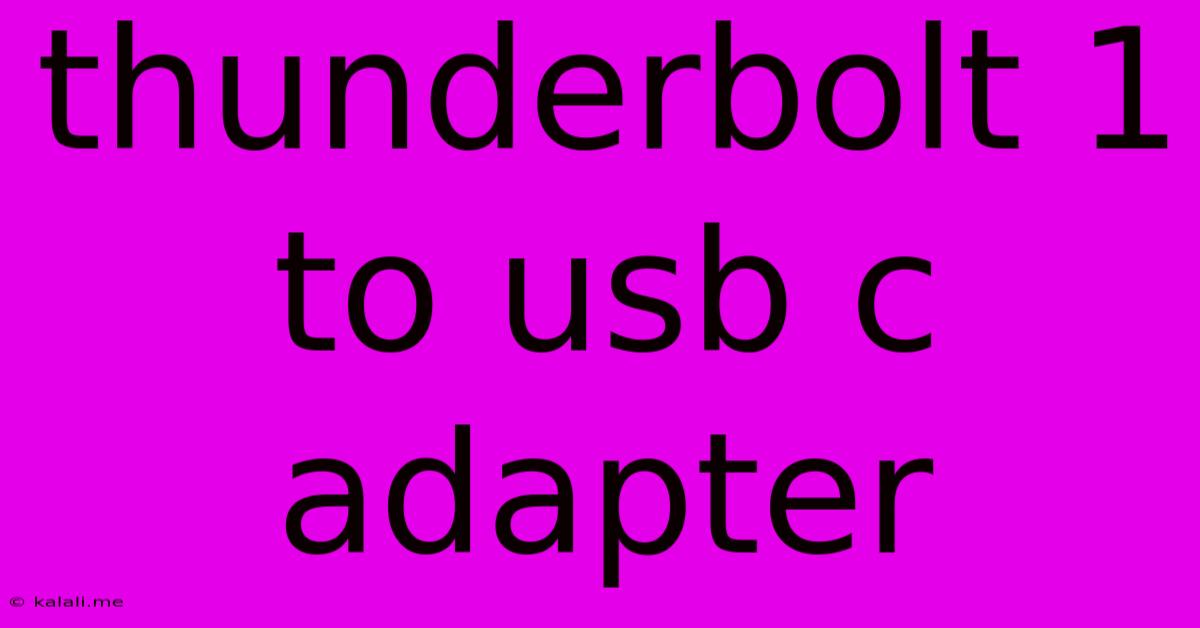Thunderbolt 1 To Usb C Adapter
Kalali
Jun 01, 2025 · 3 min read

Table of Contents
Thunderbolt 1 to USB-C Adapter: A Comprehensive Guide
Are you looking to connect your older Thunderbolt 1 devices to a newer USB-C equipped computer or laptop? Understanding the nuances of Thunderbolt 1 to USB-C adapters is crucial for a smooth transition. This guide will demystify the process, highlighting compatibility issues, performance expectations, and what to look for when choosing the right adapter. We'll also delve into the potential limitations and benefits of using such an adapter.
Understanding Thunderbolt 1 and USB-C
Before diving into adapters, let's clarify the differences between Thunderbolt 1 and USB-C. Thunderbolt 1, based on the Mini DisplayPort connector, offered impressive data transfer speeds for its time. However, it's now considered a legacy technology. USB-C, a more modern and versatile connector, supports various protocols, including USB data transfer, DisplayPort video output, and even Thunderbolt 3 and 4. The key difference lies in their capabilities and backward compatibility. While USB-C can support Thunderbolt, it's not guaranteed.
Why You Might Need a Thunderbolt 1 to USB-C Adapter
You might need a Thunderbolt 1 to USB-C adapter if you have peripherals like external hard drives, docking stations, or displays that utilize the older Thunderbolt 1 connector, but your new computer only features USB-C ports. This adapter acts as a bridge, allowing communication between the older technology and the newer port.
Compatibility Challenges and Limitations
This is where things get tricky. A simple adapter might not always work. Not all Thunderbolt 1 to USB-C adapters are created equal. Some adapters only offer passive conversion, meaning they simply adapt the physical connector. This approach often leads to incompatibility issues and limited functionality. Others incorporate active circuitry, which provides better signal conversion and ensures compatibility with a broader range of devices. However, even with active adapters, you might encounter:
- Data transfer speed limitations: While the adapter might establish a connection, the actual data transfer speeds might be significantly slower than the original Thunderbolt 1 speeds. This is especially true for passive adapters.
- Power delivery issues: Thunderbolt 1 often supplied power to connected devices. Some USB-C ports might not provide sufficient power via the adapter, limiting functionality or preventing certain devices from working correctly.
- Video output limitations: If using the adapter for video output, resolution and refresh rate capabilities might be reduced compared to a direct Thunderbolt 1 connection.
- Device compatibility: Even with an active adapter, some specific Thunderbolt 1 devices might not work flawlessly with the conversion.
Choosing the Right Thunderbolt 1 to USB-C Adapter
When searching for a Thunderbolt 1 to USB-C adapter, consider the following:
- Active vs. Passive: Choose an active adapter to ensure the best compatibility and performance.
- Data transfer speeds: Check the specifications to see what data transfer speeds the adapter supports.
- Power delivery: Verify if the adapter supports power delivery for your device.
- Reviews: Read reviews from other users to see their experiences with the adapter and specific devices.
Alternatives to Consider
Before investing in a Thunderbolt 1 to USB-C adapter, explore alternative solutions:
- Upgrade your peripherals: Consider purchasing newer peripherals with USB-C or Thunderbolt 3/4 compatibility. This often provides the best long-term solution.
- Use a Thunderbolt 1 to DisplayPort adapter and a USB-C to DisplayPort adapter (if your devices support this): This might offer better performance in certain scenarios.
- Use a docking station: A docking station with both Thunderbolt 1 and USB-C connectivity could offer a more comprehensive solution.
Conclusion
A Thunderbolt 1 to USB-C adapter can provide a bridge between older and newer technologies. However, understanding the limitations and choosing the right adapter is vital. Active adapters are recommended for better compatibility and performance. Thoroughly researching compatibility with your specific devices is crucial before purchasing. Consider exploring alternative solutions to maximize your setup's efficiency and performance.
Latest Posts
Latest Posts
-
How To Find Lego Set Number Without Box
Jun 03, 2025
-
Log Out When Inspector Tool Open
Jun 03, 2025
-
How To Take A Kwikset Deadbolt Off
Jun 03, 2025
-
Bash If Variable Is Not Empty
Jun 03, 2025
-
Postdoctoral Research Count As Professional Experience
Jun 03, 2025
Related Post
Thank you for visiting our website which covers about Thunderbolt 1 To Usb C Adapter . We hope the information provided has been useful to you. Feel free to contact us if you have any questions or need further assistance. See you next time and don't miss to bookmark.